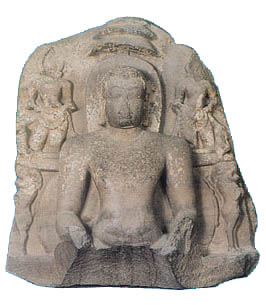Tirthankara
Height 94 cm., Breadth 70 cm.,
Bichavolu, Ramachandrapuram Taluk; East Godavari
District, Andhra Pradesh.
Circa 9th Centur AD.
The Tirthankara is in seated Dhyana pose. The
figure is mutilated below the hip. An ornamented backrest with a lateral view of a lion with a
cyclindrical cushion is on his back. His Yaksha attendants are shown one on each side
just above the backrest. The Bha Mandala at the back of his head is in the usual
form. Mukkudai is above his head. He has curly hair and very long ear lobes. We see
this pattern in the Eastern Chalukya sculptures.
|

|

|
Ajithanatha
Height 67.5 cm., Breadth 59 cm.
Peddatumbalam, Bellary District, Karnataka.
Circa 12th Century AD.
Ajithanatha, the second Tirthankara is depicted in
seated Dhyana posture in Padmasana (lotus pose) on a lotus base. His hair is
shown in curls. This type of hair depiction is also common to sculptures of the Buddha. At his
back is an ornamented backrest with Makara designs. Depicted further recessed are Chamara
bearers, one on each side. They bear a fruit in their free hands. Their head-gear is in the
form of Karanda Makuta (the crown is in the form of a cone with the base at an angle
of 30° pointed towards the apex; this shape is supposed to resemble the neck of a peacock). A
round Bha Mandala (aura) is shown at the back of the Tirthankara's head.
Over it is shown the Mukkudai or the triple umbrella. The arch having floral designs
(Prabhavali) with a Simha mukha (lion face) enchances the beauty of the
sculpture. The ornaments of the Chamara (fly-whisk) bearers and the floral peral
string designs of the Mukkudai and the arch shown iit as akin to Hoysala
style. On that basis, we may assign the date of this sculpture to Circa 12th Century AD. There
is no cognisance in this sculpture to identify him as Ajithanatha. But in the Museum
Register, this sculpture is recorded as Ajithanatha.
|